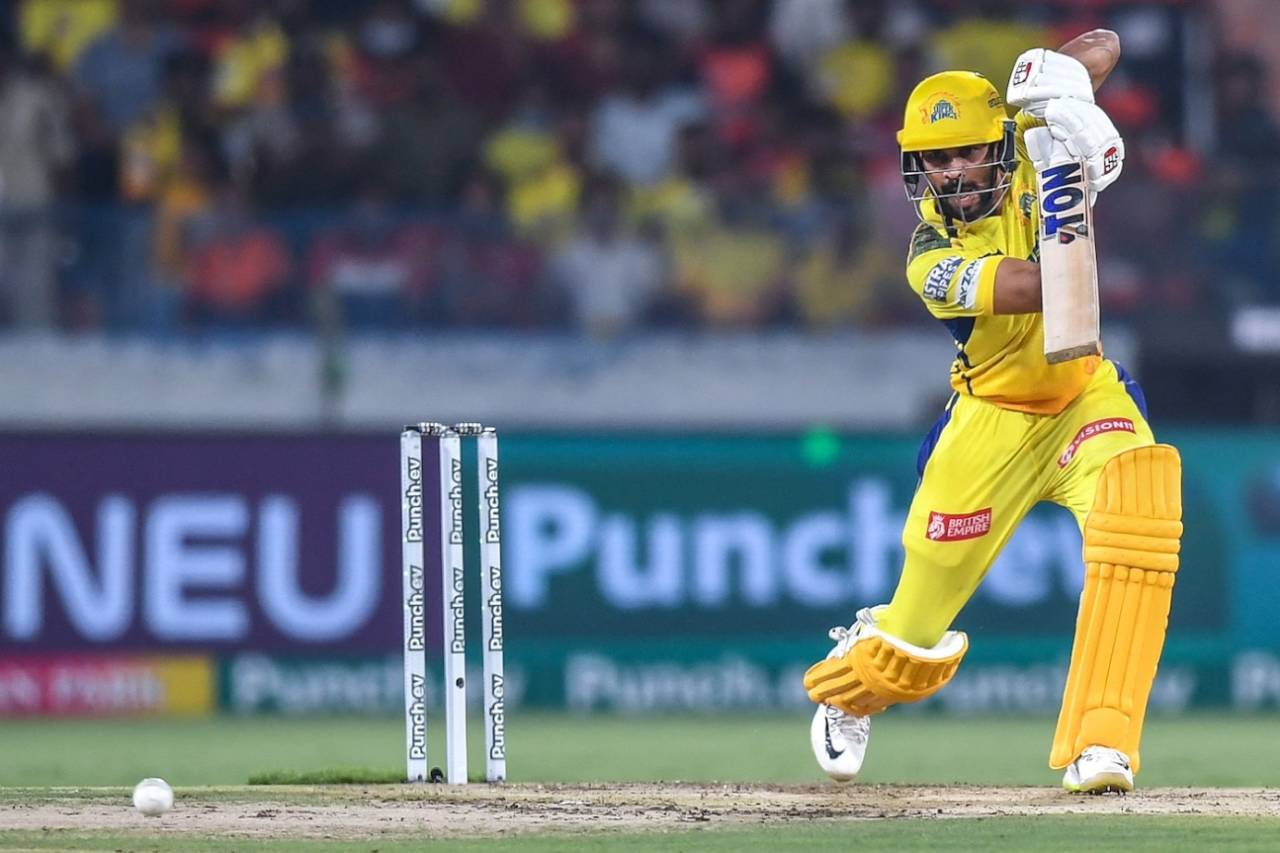Ruturaj Gaikwad, the anchor at the top weighing CSK down
CSK's captain is playing to the CSK template - or idiosyncrasy, if you like - but he might just be taking it too far
Sidharth Monga
05-Apr-2024

Ruturaj Gaikwad scored 26, but it took him 21 balls to score those runs • AFP/Getty Images
Chennai Super Kings might not be the most innovative T20 side, but they hardly ever get the basics wrong. The roles of their batters are clear; their batting pairings are complementary; they rarely get caught playing at the wrong tempo. This season, though, they have a problem at the top: their captain Ruturaj Gaikwad.
That he is not getting big runs or that he is averaging 22 is not that problem. The problem is that he is starting too slow and not staying long enough to compensate for those slow starts. Gaikwad is the third-slowest batter in the powerplay across teams this year.
Not all of it is unplanned. If you look at Rachin Ravindra's intent, it seems Gaikwad has picked up the role Devon Conway played in the last IPL: batting long. That has for long been a CSK idiosyncrasy: they want only one of their openers to go. But just how slow the other opener goes can have an unwanted impact.
Gaikwad does seem to have taken it too far. Along with Shikhar Dhawan, Gaikwad has been the slowest opener in their first ten balls this IPL. Even Jos Buttler, who looks very out of sorts, is slightly quicker. The thing with Gaikwad is that he doesn't even look in poor nick. It is just lack of intent. Only David Miller and Ajinkya Rahane have shown less aggressive intent than Gaikwad in their first ten balls this IPL. Neither of them is an opener.
If you look at the overall development of Gaikwad the T20 batter, this IPL seems to be the one where he has regressed after an excellent last year.
At his core, Gaikwad has been just the kind of top-order batter India have been looking to get rid of: slow to start but putting up big season aggregates at strike rates of around 130.
However, Gaikwad batted differently in the last IPL. He went at 127.30 in his first ten balls, and 147.50 overall. This year, he is back to under a run a ball at the start. As it turned out in Hyderabad, this kind of approach puts all the eggs in one basket. It needs the other opener to keep having great days, and it leaves you with no option but to bat long. If you get out looking for that promised acceleration, you leave the team in a hole.
As it turned out in Hyderabad, Gaikwad went from 13 off 13 to 26 off 20. Ravindra got out with a low-percentage boundary attempt. With Rahane in, the run rate not high, Sunrisers Hyderabad could turn to spin to shut CSK down. Gaikwad had no option but to take spin on because that is not Rahane's match-up, and he holed out, making it 54 for 2 in 7.1 overs and leaving the rest a hole to climb out of.

Abhishek Sharma, the anti-Ruturaj Gaikwad•AFP/Getty Images
The opposite of what Abhishek Sharma did - his 37 in 12 balls meant that even though he got out in the third over, SRH had a powerplay score of 78 for 1. There was the slowdown against spin later, but SRH were never in a hole.
Whatever Shivam Dube managed after Gaikwad's dismissal - and it was a sensational 45 off 24 - was only damage control. Pat Cummins, by now no stranger to shutting down unenterprising teams on slightly slower pitches in India, got his teeth in and led from the front in using changes of pace. The SRH quicks bowled nearly half of their deliveries off-pace; they went at 116 when they bowled slower balls and 135 when they went on-pace.
At the post-match presentation ceremony, Gaikwad said he felt CSK were well-placed at 80 for 2 in ten overs and that the back-end wasn't great. But that 80 for 2 was thanks largely to Dube playing a blinder. Both teams struggled against the lack of pace once the ball got old, which does point to the powerplay again.
In a year when the overall powerplay scoring rate is 9.27 an over, CSK might want to revisit their tactic of retaining one anchor opener, and the extent to which he anchors. Especially as the pitches tire, and the powerplay becomes the best time to score runs in.
Sidharth Monga is a senior writer at ESPNcricinfo